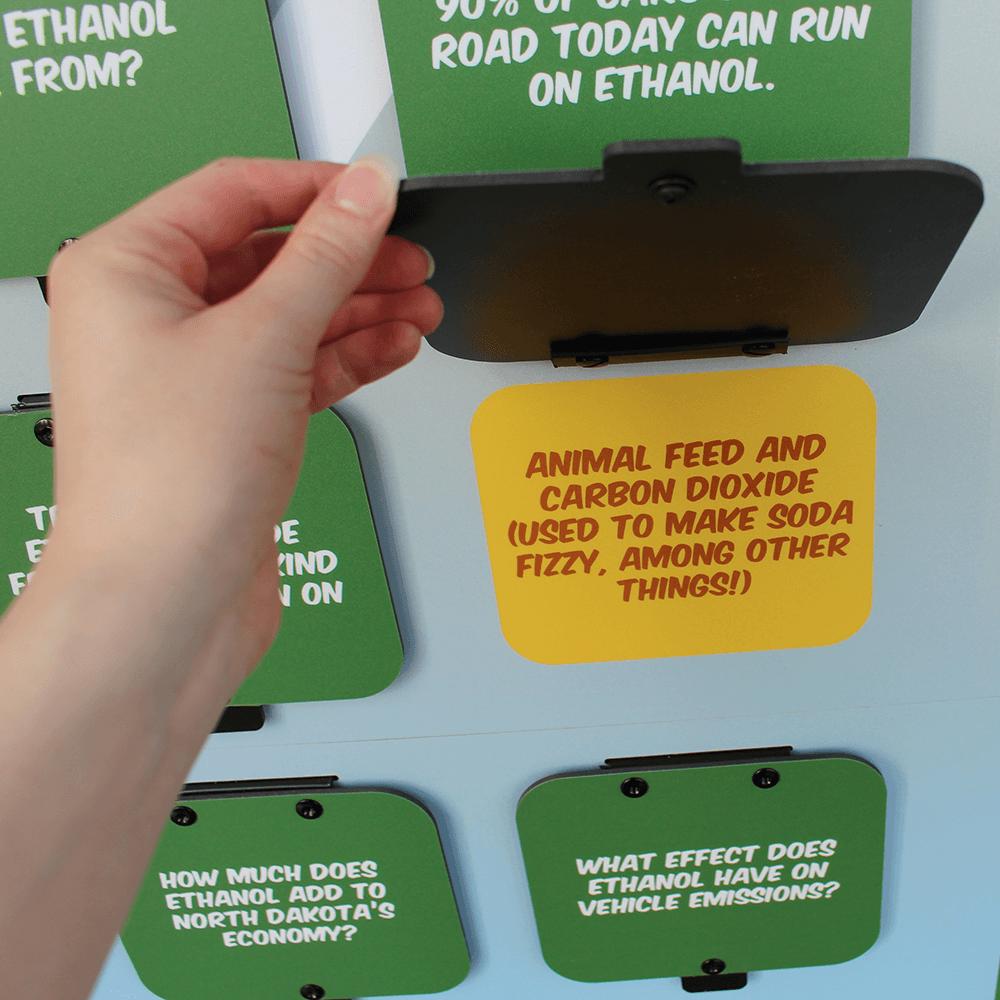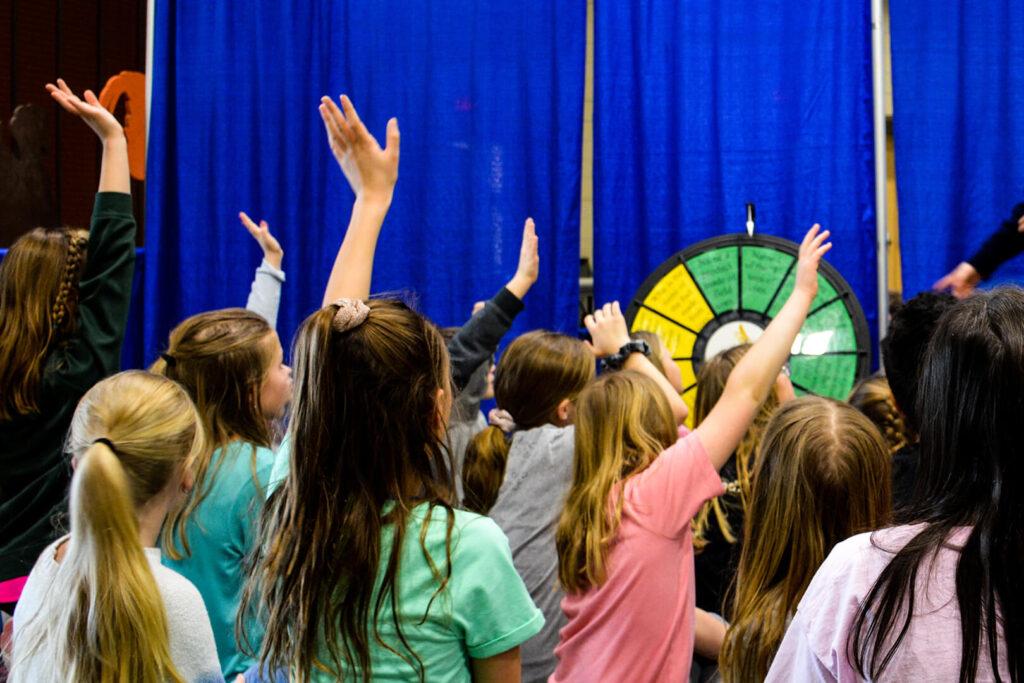
Commodity checkoffs stretch from sea to shining sea, supporting farmers or ranchers through promotion, market development, and more. They’re also one of the biggest players in the field of ag education. We see it all the time: checkoffs are second only to farm bureaus among our top customers.
We’ve partnered with North Dakota’s corn checkoff for years, providing standup displays and realistic corn models for their programs. So they were a natural choice when we started thinking about ag educators to interview for this series.
Heidie Haugo, North Dakota Corn’s communications director, was kind enough to sit down and chat with us. We talked about North Dakota Corn’s consumer outreach, what facts they try to share, and why Heidie loves ag education. (We’ve lightly edited and condensed this transcript for length.)
Exhibit Farm: So what do you do on a day-to-day basis?
Heidie Haugo: I am primarily the point person on education. Right now, we have Ag in the Classroom events in the spring, where I go out and touch base with fourth graders.
In North Dakota, the standards of the fourth-grade curriculum have students learning about their state specifically. So this is where we think learning about commodities really makes sense. We go out to agriculture trade shows across the state, and the schools bus in their fourth graders as a field trip.
I talk about corn, all the different types of corn you can grow in North Dakota, what you can use corn for, the economic impact corn makes on the state, those types of things. We try to make it really fun for them; they go home with little goodie bags and stuff. Then we send some additional curriculum home with the teachers so they can follow up.
And then there are also events throughout the rest of the year. We’re at a lot of county fairs. We have an exhibit and an ag adventure day with the local zoo in Fargo. Some of our folks at the North Dakota State University put on educational events for teachers, [about] ethanol for example. They’ll teach them how ethanol is made, take them out to some of our ethanol plants, and then they can take that back to their students.
We also recently did a workshop for college students [studying] to be automotive technicians, to talk about ethanol and dispel some common misconceptions. So when they go into the workplace, they can talk about all of the good things ethanol does and recommend it for their consumers.

EF: Wow, that’s a lot! Across all those programs, what are some of the big-picture concepts you want to share with consumers?
HH: We talk a lot about ethanol. About fifty to sixty percent of the corn grown in the state goes to one of our five ethanol plants. Quite a lot of that ethanol that’s not used in the state is exported to other countries through the Pacific Northwest, so we talk a lot about those trade relationships. That’s a huge piece we like to educate on, the importance of trade.
And then for consumers that are not attached to agriculture, we talk a lot about those misconceptions about ethanol. That’s a huge piece of our educational programs, just making sure people know that it’s safe to use, that it’s very affordable, and it’s very clean-burning. And it makes a huge impact in North Dakota because having those five ethanol plants means a lot of jobs. It’s great for the North Dakota economy.
EF: I remember the fuel pump display that we did for you guys a while ago. What kind of response have you seen to that?
HH: That was really popular. We used [that] at the zoo; we’ve used it at the fair. Those are engaging exhibits — people like to come up to them, they can touch them, flip the little handles up. You don’t even realize you’re learning. But later when somebody says something, your memory is jogged and you can say, “Hey, did you know you can use ethanol in any vehicle?”
That’s something I [also] like to share with students at our Ag in the Classroom events. I like to talk about [how] any fuel in the US at this point is at least 10% ethanol. So even if you’re just using unleaded fuels, you’re [still] fueling your car with corn. The kids really like that stat. And then they go home, they tell their parents next time they’re at the [gas] station, “Did you know you’re putting corn in the car?” That kind of education extrapolates and goes to the parents who make purchasing decisions, and it just continues to carry on.

EF: Since most corn isn’t used for consumer products (except fuel), how does expanding consumers’ ag literacy help the corn industry? Can you explain that relationship a little bit?
HH: Well, we do talk about human food as well. Corn does end up in some products, like cornflakes, corn tortillas, corn syrup in sodas, things like that. But in North Dakota, the corn industry plays a huge economic role. [There’s] a lot of farmers in North Dakota, and maintaining those relationships between farmers and consumers, especially as students get more and more removed from the farm, is so important.
We want consumers of all ages to be able to understand what ag provides for them, and that people will always need agriculture. Putting a face to that is so important, putting a face to the individuals who are caring for the land and the livestock and who are working to bring food to their table, is so important. And it’s important for building trust as well in the agriculture field.
EF: Last question: why did you decide to pursue ag education as a career? What do you like about it?
HH: So I actually grew up on a farm in southern Minnesota, and I was very involved in 4-H and FFA growing up. I studied ag education in college, and I always knew, I think, that I was going to be involved in agriculture long-term. I started working for Minnesota Corn right out of college, and then I got married and my life brought me to North Dakota. So I was very fortunate to end up in a similar role here.
What keeps me involved in ag education is seeing those lightbulb moments for students when they realize all the places that agriculture touches our lives. We got a rug this year made out of corn fibers for students to sit on in our booth. And when [I] say “Oh, you can make fiber out of corn,” [they ask] “What kind of fiber?” Then I can say, “Well, you’re sitting on it, that’s made out of corn”. And just to see their faces light up, it just keeps me coming back.
[It] brings joy to me as well, being able to help students discover the world around them and to realize how many places ag really does touch their life. We wouldn’t have anything without agriculture.

